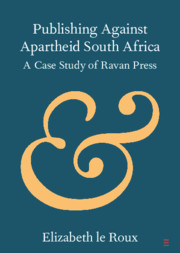Element contents
Publishing against Apartheid South Africa
Published online by Cambridge University Press: 08 December 2020
Summary
- Type
- Element
- Information
- Online ISBN: 9781108642736Publisher: Cambridge University PressPrint publication: 07 January 2021
Bibliography
Primary Sources
Secondary Sources
- 6
- Cited by



